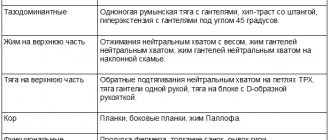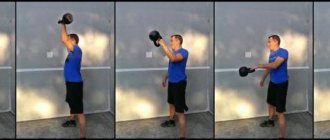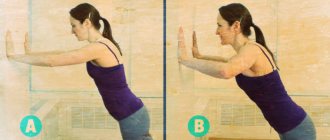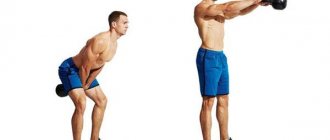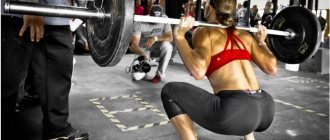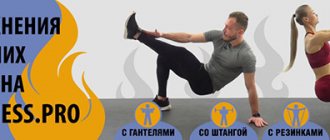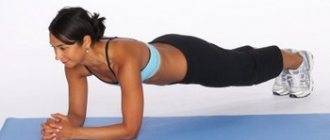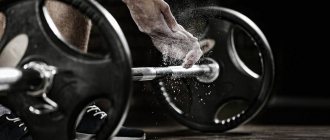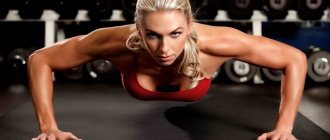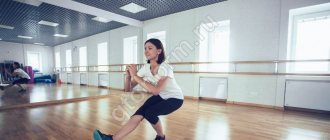Useful tips
Have you ever had to run (or at least walk) up the stairs, and when you reach the desired floor, you realize that your fitness could be better?
Even if you eat healthy and exercise regularly, there is always room for improvement.
If you're wondering how strong and fast you really are, there are a couple of tests you can take to test it. Here are 15 ways to evaluate your fitness:
You endure a minimum of 2 hours of moderate to hard training.
Vary your workouts so they aren't monotonous. Try to train at least 2 hours a week, challenge yourself and try to improve your results.
Experts advise exercising at least 150 minutes per week. Your workout should include walking. For a more active workout, you can go jogging or do aerobics. Recommended time 75 minutes.
Don't forget to rest and eat on time - this is very important for recuperation.
If you can’t do such long workouts yet, don’t worry. Try to improve your results little by little without overworking yourself.
You can easily touch your toes.
This is a great workout for improving coordination. If you want to check your physical condition, try stretching your arms along your body or at least touching your toes (without bending your knees).
If your muscles are feeling very tense or pulled, then it may be time to start doing yoga.
If you want to improve your flexibility at home, experts recommend adding stretching to your daily workout.
Try stretching your hamstring for 30 seconds three times a week, not too aggressively, but rather gently to avoid damaging the muscle. Within a month you will already be able to see results.
You are able to run 2.5 - 3 km.
Doesn't that sound too tempting? Special forces soldiers run 3 or 5 km a couple of times a week and 10 km about once a month, with an additional weight of 12 kg and breathing only through the nose.
If you find it difficult to run three kilometers, don't worry - it can be trained. Run less, but gradually increase the distance and speed.
And don't forget about the importance of changing your workouts, for example, you can switch to cycling or swimming (a less traumatic activity that is suitable for everyone, especially older people for whom running can cause pain in the legs and in particular in the knees).
Here's a chart that will help you check your physique based on a 2.5K run. The more time you have to run, the more you should train.
How useful is this?
Let’s say right away that in the process of training, the basis of which is the “Plank”, a large number of muscles are activated. The fact is that the body at this moment is practically in limbo, and therefore it activates all groups of the musculoskeletal system to maintain the correct posture.
Maintaining balance is achieved in the following way: the load is distributed evenly to all parts of the body, which contributes to the development and strengthening of all muscles, which after some time will begin to gain strength and elasticity. The result of all this is a slender and sculpted body, attractive shapes and refined silhouette lines.
Today, there are a huge number of techniques that differ from each other in complexity. But the basis for them is the classic version, which we will talk about in more detail a little later. Today we invite you to choose several techniques and complete a thirty-day course. It must be said that the schedule that will be described below is short in duration and convenient, which may be of interest to a large number of people, even desperate workaholics who devote all their time to their favorite job.
Classic version
The main advantage of the plank is the fact that to perform the exercise there is no need to buy expensive gym memberships, you just need to have a special mat on hand, as well as incredible willpower and an endless supply of patience.
Advice! Dear girls, we all often get tired, lack sleep, eat poorly and walk around in a sad mood. It's time to end this! And before you can establish the rhythm of life, you need to get your body in order, stopping at nothing to achieve your goal! Gather all your willpower and think about how great you will look in a month, and then no amount of fatigue will make you deviate from your intended path.
By the way, scientists have long proven that any physical exercise, no matter how complex and difficult it is, leads to improved mood and well-being. After the body has once again undergone intense work, relaxation and vigor come, and depressive thoughts and inexplicable anxiety fade into the background and are gradually forgotten.
You will be able to notice the first changes in your appearance within a few weeks. For additional motivation and as a decisive argument, we will attach photographs of the girls, as they say, “before” and “after” to the article. The beauty of the plank is that you don’t have to spend a lot of time doing it every day.
https://youtu.be/JaJsLRf35wQ
You can do 20 lunges.
This is a great exercise for your torso, legs and butt. Lunges work many different muscles. That's why they're so useful. If you can do at least 20 lunges without falling or staggering, then you're in great shape.
Want to improve your fitness? Try some variations of this exercise that will test your balance and lower body strength. You can add one dumbbell in each hand for extra resistance.
How to perform lunges correctly
Using an adjective
OP is written with two “n” in the following cases:
- If a word is formed from a perfective verb, there are few such constructions in the Russian language, but they can still appear in writing: “assembled machine gun,” “purchased product,” “cut-off shotgun,” and so on. Exceptions deserve special attention, since they will have to be remembered: “baptized mother”, “smart child”, “wounded soldier”, “sister” (but “named by last name”). Therefore, checking the form of the verb is extremely important.
- If the OP is formed from a verb with any prefix except “not” - “cleared building”, “overloaded truck”, “frightened child” and so on. As exceptions, it is usually customary to single out three constructions that are used in writing much more often than others - “uncleaned”, “uninvited”, “unafraid”. However, other words that are formed from a verb with the prefix “not” can also be included here.
- If the adjective is formed by adding the suffix “evanny” or “ovanny”. Some examples of the use of such OPs in sentences: “The varnished lids must be produced according to the plan,” “I had to fill the text with rhyming sentences,” “According to the plan for the implementation of the contract, the uprooted trees had to be taken out of the city.”
Suffixes with one “n” are usually written in other cases, that is, if the construction was formed from an imperfective verb and is not an exception if it does not contain the suffixes “ovanny” and “evanny,” as well as any prefix other than “not.” As for the short forms of OP, it is customary to write as many “n” in them as in the full ones.
Learning how to correctly spell the word "done" is not that difficult. It is much more difficult to learn to correctly recognize such structures in writing. However, if you practice this daily, then you can practically forget about the mistakes made in such things.
https://youtu.be/ydJ5F1ffZsU
You have a healthy BMI (Body Mass Index)
Body mass index is a measure that makes it possible to indirectly estimate a person’s weight in order to find out whether it is normal, above normal or below normal. This measurement is based on a person's weight and height.
To find out your body mass index, use the formula: I = m/h2
(i.e. BMI=kg/m2)
· m
— body weight in kilograms
· h
- height in meters,
Here is an example: Let's say a person's weight = 106 kg and his height = 168 cm. His mass index would therefore be: BMI = 106: (1.68 × 1.68) = 37.55 kg/m²
Calculating your BMI online is a great place to start, but keep in mind that it has limitations. You can find a BMI calculator online, but simply entering your age, height and weight won't tell you how much fat or muscle you have. If you are serious about your fitness, it is better to use special scales or other more serious methods that will allow you to better understand the volume of fat and muscle.
Climbing Squats
It's no secret that footwork in rock climbing is no less important than hand work. And in some cases, the legs are even more important. Therefore, squats and other similar exercises (lunges and rolls) are considered basic in rock climbing. You won't be able to effectively perform a crunch or a toe roll if your knees don't bend. You won't be able to do leg rolls if you don't do pistols regularly.
Exercises required for climbing training
- Classic squats
- "Squat Monkey" - wide stance squats
- "Pistols" - one leg squats
- Rifles
- "Triangles" - side lunges
Most often, these exercises are performed during warm-up or, conversely, closer to the end of the workout - between the main climbing and stretching, because in the technique of footwork in rock climbing, flexibility is no less important than strength.
If the article was useful, share it on social networks and write comments.
Your resting heart rate is low
During exercise, the heart rate increases, but if at rest the heart rate is low, then this is a good indicator. The normal heart rate range can range from 50 to 100 beats per minute, although most people fall between 60 and 80 beats per minute.
It is worth noting that a low heart rate in a person who does not engage in physical activity may indicate heart problems. But most athletes have a fairly low heart rate.
You can check your fitness level by looking at the time it takes for your heart rate to drop to normal levels after a workout. The better your physical shape, the faster your heart rate returns to normal.
Working muscles
The classic plank is a general strengthening exercise and loads on one or another muscle group and the musculoskeletal system, stretching and tightening most of the muscles of the human body. Various types of planks are aimed at increasing the efficiency of the load on a particular muscle group. The classic plank is especially good for:
- Abdominal muscles, especially the rectus and lateral muscles. The press experiences a significant load, holding the body above the floor surface and preventing it from sagging.
- The pectoral and deltoid muscles ensure a static position of the shoulders and maintain balance during the plank.
- The gluteus maximus, medius and minimus, quadriceps, and calf muscles are responsible for the position of the pelvis and legs.
- The back muscles and deep muscles of the back of the head support the body in a straight, straight position and are subject to the main loads.
The classic plank is aimed at developing the abdominal muscles, which are responsible for stabilizing the musculoskeletal system and the position of the internal organs of the abdominal cavity. Flabby and loose abdominal muscles threaten the owner not only with an unkempt appearance, but also with problems with the digestive and excretory systems.
You can easily run up the stairs, jumping over 4-5 steps at a time.
It may seem easy until you try. According to Harvard scientists, although there are more modern ways to measure a person's physical health today, this staircase method is still an excellent test of your cardiovascular endurance.
Don't have five flights of stairs? All you need is one step and a stopwatch. Check how many times you can get up and down in a minute. After this, you can check your heart rate.
You can perform the “High Chair” exercise (holding the support while sitting against the wall) for more than a minute.
This exercise can be done at home. It only seems simple, but it is not. To get into the wall-sit position, stand with your back to the wall and squat down so that your back is straight and your thighs are parallel to the floor.
Experts believe that men who can hold this position for more than 100 seconds, and women who can do this exercise for 60 seconds, are in excellent physical shape.
If you have difficulty maintaining this position, try regular squats with added weight. You can also do lunges to build muscle.
How to do the chair exercise
You can perform a standing long jump of at least 2 meters.
Here's a true test of your fitness: see how far you can jump from a standing start (without a running start).
Stand on a line with your feet shoulder-width apart, bend your knees, swing your arms back, then forward, and jump as far as you can. The length is calculated at the heels. Test yourself.
The average person can jump 1.5 meters, but someone who is in excellent physical shape can jump 2 meters.
This test tests both your strength and your speed. If you want to improve your results in this exercise, try incorporating squats with additional weight into your workout, as well as kettlebell lifts for more explosive movements.
Squat Variations
The most common options are:
- regular squats on two legs, without weights or with dumbbells;
- plie squats (with legs spread as wide as possible);
- squats with an emphasis on one leg in front - “scissors” (lunges);
- squats on one leg (“pistol”);
- squats with a ball (in variants when the ball is sandwiched between the legs).
And many other techniques.
https://youtu.be/qxaBuSBO-Sc
Possible injuries from squats
Squats are an extremely effective and useful exercise, but they require strict adherence to technique, otherwise they can become traumatic.
The main danger when performing squats is possible injuries to the back and knees.
The basic rules to avoid injury are:
- Squats should be performed with a straight back. When you “round” your back, too much stress is placed on the spine (especially in its lower part).
- When squatting, your feet should be kept in line with your knees: this avoids dangerous torques in the joints.
- If the muscles involved in the movement are not strong enough, it is recommended to avoid deep squats (in which the hip joint drops below the knee joint).
Common Squat Mistakes
1. The general direction of the movement is downward and forward (squatting “on the knees”). 2. Excessive forward movement of the knee joints when lowering. 3. Extension of the knee joints is ahead of extension of the hip joints. 4. Bringing (less often spreading) the knees together when performing the exercise. 5. Raising the heels due to the transfer of the central mass to the toes. 6. Flexion of the cervical and/or lumbar spine.
https://youtu.be/t8fUlq53Z8s
You can run 200 meters in less than 30 seconds.
Almost everyone can run 200 meters, but the most important thing here is speed.
According to experts, a person can test his strength and speed by running 200 meters against the clock. Olympic champion Usain Bolt can run this distance in less than 20 seconds, but of course other people are not so fast. If you can run 200 meters in less than 30 seconds, you are in excellent physical shape.
Want to improve your speed? Run intervals on days when you have a cardio workout. Also squat with additional weight - this will give your legs strength.
In 1 minute you can do 60 abdominal crunches.
So-called crunches are a common part of any workout. If you want to test your physical development, try timing yourself and counting how many crunches you can do in one minute.
To start the exercise, you first need to take a lying position, bend your knees so that your heels are at a distance of 45 cm from the pelvis. Place your hands on the sides of your head, not behind your head, with your palms facing down.
If you can do 60 crunches in 60 seconds, you're in great shape. Even if you do 45 crunches, you already have good form.
How to do crunches correctly
https://youtu.be/QzDem2K5yD8
How to correctly perform speech therapist tasks
Evgenia Larina
How to correctly perform speech therapist tasks
An important role in the cooperation between parents and speech therapist is given to homework , the completion of which will help to successfully correct the child’s speech. For homework to be productive, a number of conditions must be met :
1. Assignments must be repeated and reinforced throughout the week (they can be rewritten or photographed)
.
2. Prepare a comfortable, well-lit place for your child to study.
3. Classes can be conducted during walks and trips. But some types of tasks require a calm environment, without distractions.
4. Class time (15 - 20 min)
should be fixed in the daily routine.
5. Create positive motivation for doing homework , its future prospects and benefits.
6. Set your child up to complete the task . Put things aside. Let your child feel your interest and enjoy communicating with you.
7. Classes must be systematic, since the skill is formed as a result of constant repetition; otherwise, sound automation may take longer.
8. right time for classes: the child should not be tired, sick, or sleepy; It is unacceptable to tear a child away from his favorite activity; Do your homework at the same time.
9. Classes should be short and not cause fatigue or satiety. It is advisable to tell your child what tasks he will do tomorrow .
10. It is necessary to determine which of the adults will work on the instructions of the speech therapist ; it is necessary to develop uniform requirements for the child.
11. Read the assignments , make sure everything is clear to you. In cases of difficulties, consult with a teacher or speech therapist .
12. Read the task , discuss and talk with your child about its implementation .
13. Perform in front of a wall mirror.
14. Articulation exercises are introduced gradually, achieving clear, correct execution, counting , with maximum range of motion, symmetrically with respect to the right and left sides of the face.
15.Each exercise is practiced in the following sequence: naming and showing the exercise to adults, doing it together with the child, analyzing mistakes, showing it again to adults and doing it again by the child .
16. Start the lesson with simpler tasks , make it more difficult gradually, do not rush him, give him time to think.
17. Don’t rush to teach your child everything at once; master each task gradually . Only when the previous one has been mastered, move on to the next one.
18. Read the assignments to your child clearly and loudly. If necessary, explain unfamiliar words and expressions.
19. Assigned poems , tongue twisters, tongue twisters must be learned by heart.
20. It is useful to periodically return to previously studied material in order to consolidate correct pronunciation .
21. An effective technique is a game. the task for some toy in a playful way
22. Do not complete tasks for your child . The speech therapist will still notice it.
23. Don’t forget to praise your child not only for success, but also for effort.
24. Avoid the words “What you said is wrong ”
,
“This is the wrong answer”
,
“You are not listening attentively”
, the best options are
“Let’s think together”
, “I will name two
(three)
words, and you choose the appropriate one”,
“Listen again”
;
25. Be patient with your child and attentive to him during classes. You must be friendly, sympathetic, but quite demanding.
26. The speech of parents should be a model for the child.
27. If you notice that your child has lost interest in an activity, stop it and resume it again after some time.
28. Do not focus your child’s attention on the shortcomings of his speech. However, when the sound being studied is at the stage of consolidation, it needs to be corrected .
29. If you don’t succeed in some task , take on another one, and come back to this later - you shouldn’t leave your child with the feeling that you can give up something, leave something unfinished.
30. It is necessary to finish the work on a positive note.
Flexibility Test: Sit and Stretch
This is a simple test that will test the flexibility of your hamstrings, legs and lower back.
Here's how to do it:
- Place any stick or ribbon on the floor. You can attach it to the floor with tape.
- Count 35 cm from this stick, and mark this distance by drawing a line with chalk or gluing multi-colored tape or tape to the floor.
- Sit on the floor so that your heels are on the ground.
- Slowly begin to reach towards the tips of your toe hoops, exhaling and holding this position for about a second.
- Mark the distance to which you managed to reach your fingertips.
- Repeat the test 2 more times.
— Write down your best attempt.
How to do a flexibility test
Fitness testing for advanced athletes
This test was invented by the famous trainer Bobby Maximus, who also works with representatives of special forces.
According to him, if you can complete this test, you are physically more developed than 99% of all people on the planet.
In fact, his test consists of 20 points, but if you just want to be in excellent physical shape, then it’s enough to know these seven points:
15 strict pull-ups
A test that helps you engage all your muscles - lower body, core and upper body. If you can do 15 strict pull-ups, you have little or no excess weight and know how to use your muscles.
Squats with a weight exceeding 2 times your own
This exercise works the strongest muscles in your body—the quads, glutes, and hamstrings—and lifting twice your own weight proves that your legs are very strong.
How to do squats with heavy weights
10 kilometers in 50 minutes
If you can run 10 km in 50 minutes or less, then your lungs are in excellent condition and you can recover quickly.
Turkish get-up with 1/2 body weight
This is a full body exercise. It helps maintain mobility throughout the body. If you can get up off the ground with half your body weight above your head, your abdominal muscles are very strong.
What is a Turkish rise
Bench press with body weight 10 times
If you can bench press a barbell with your body weight 10 times, then you will most likely pass most push-up tests.
How to do the bench press correctly
500 meters on a rowing machine in 90 seconds
This test can show how developed your lungs are and how capable your muscles are of handling short bursts of effort, which is an important factor for Special Forces soldiers or UFC fighters.
2,000 meters on a rowing machine in 7 minutes
Like the previous test, this exercise requires good lungs, but it is also a test of mental strength. Halfway through you will want to give up, and this test tests your willpower.
For the test you will need:
Clock with stopwatch and timer.
Objects for recording results (paper and pen, for example).
It is advisable to have someone help you count the reps.
It is advisable to have a heart rate monitor.
MK polo fastener on a product with an edged neck
Once I was sewing a bodysuit for my youngest son and I wanted to sew a polo clasp, I was tired of the buttons on the shoulder. The classic version didn’t seem appropriate for a baby, so instead of a collar I simply edged the neckline. There is a version of such a bar with a bend in Ottobre 2013-03, I have a modification). It turned out like this
We wear these bodysuits with pleasure, they are comfortable. At the request of the girls, I am sharing the technology. If you have any comments, I will take them into account for the future. Feel free to correct me, I'm open to constructive criticism. I sewed slips and took pictures of the process. The photos were taken under artificial lighting, so I apologize in advance for their quality. This is the finished result
and now the process itself. Select the width of the strip. I have 3 cm, but you can make 2.5 or 3.5, depending on the size of the product. We mark the line of the middle of the front and from it set aside half the width of the bar (1.5 cm). If the clasp is on the male side, like mine, then the clasp is shifted to the right, if on the female side, then it is mirrored. Mark the length of the bar. I have a blank with sleeves, but just stitched shoulder seams are enough.
Now we strengthen the inside under the fastener with non-woven fabric, I have a regular adhesive non-woven fabric. the length of the non-woven strip is equal to the length of the fastener + 2cm; the width of the interlining is 5cm, but it could have been 4cm, a little wider than the strip. I then freely remove the excess when the fastener is ready. We glue the interlining so that it is glued clearly in the middle. Let's prepare the bar itself; I have it from companion fabric. The length of the strap is equal to the length of the fastener + allowances 3 cm (1 up and 2 cm down) The width of the strap is 3 cm * 3 = 9 cm + allowances for overlocking 1.5 cm. Total 10.5 cm. I completely reinforce the bar with non-woven fabric and overlock it with an overlocker on the long sides.
I transfer the line of the fastener to the wrong side and draw it with chalk along the interlining. I make a 2cm cut at the top to edge the neckline
and actually edging it
I mark the line of the fastener on the back of the strap detail. I do it on the male side, and mirror it on the female side. I set aside 6.7 cm on the left and draw a vertical line - 0.7 cm overlock allowance + 3 cm + 3 cm (since the inside of the strap is double). 3.7cm remains on the right (3cm outer flap +0.7cm overlaid edge). I couldn’t take a photo of this moment, if it’s not very clear, I’ll add a drawing. I overlap the front piece with the placket piece so that the fastener line marks on the front and the placket coincide.
I pin and stitch along this line, starting from the edging. I sew to the end of the fastening line, turn around and sew at a distance of about 1.5-2 mm from the previous line, finish the line by sewing the edging. that's what happened
Now we cut off the excess neck edging and cut the part between the lines, being careful not to damage them
This overlayed edge should cover the stitching seam of the trim.
turn it inside out and iron it.
we put a stitch in the stitching seam of this strip so that it does not turn out
Iron and place a stitch that secures the strips along the bottom edge of the fastener. I usually sew in a rectangle, but I just sew one line, I like it better that way.
I overlock the bottom edge of the strip with an overlocker and hide the threads with a crochet hook to prevent unraveling.
